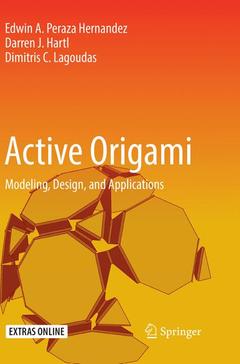Active Origami, Softcover reprint of the original 1st ed. 2019 Modeling, Design, and Applications
Auteurs : Peraza Hernandez Edwin A., Hartl Darren J., Lagoudas Dimitris C.

Origami structures have the ability to be easily fabricated from planar forms, enable the deployment of large structures from small volumes, and are potentially reconfigurable. These characteristics have led to an increased interest in theoretical and computational origami among engineers from across the world. In this book, the principles of origami, active materials, and solid mechanics are combined to present a full theory for origami structures. The focus is on origami structures morphed via active material actuation and formed from sheets of finite thickness. The detailed theoretical derivations and examples make this an ideal book for engineers and advanced students who aim to use origami principles to develop new applications in their field.
Edwin A. Peraza Hernandez is a postdoctoral researcher in the Department of Aerospace Engineering at Texas A&M University. He obtained his B.S. and Ph.D. degrees in Aerospace Engineering from Texas A&M University in 2012 and 2016, respectively. His research interests include structural mechanics, design optimization, active materials, origami, and tensegrity. Edwin is the author of more than 28 technical publications in archival journals and conference proceedings and has received two best paper awards.
Darren J. Hartl received his BS in Aerospace Engineering in 2004 and Ph.D. in Aerospace Engineering in 2009, both from Texas A&M University. He currently holds an Assistant Professor position at Texas A&M in his home department, and his work bridges the topics of advanced multifunctional material systems and their integration into aerospace platforms. After over three years as a Research Assistant Professor at Texas A&M, Dr. Hartl held jointappointments at the Air Force Research Laboratory (AFRL) in the Materials and Manufacturing Directorate and Aerospace Systems Directorate. At Texas A&M, Dr. Hartl maintains an active research team consisting of graduate, undergraduate, and postdoctoral researchers. He has over 16 years of experience working with shape memory alloys and morphing structures and his efforts have included both experimental and theoretical studies. Since 2006, Darren has co-authored 146 technical publications on the topics of active materials modeling, testing, and integration into morphing structures. He has given over 25 invited talks or seminars (9 international) and has taught short courses on SMA theories in the US and Europe. Since 2014, he has served as an Associate Editor for the Journal of Intelligent Material Systems and Structures. He was recently selected as the 2016 recipient of the ASME Gary Anderson Early Achievement Award.
Dimitris C. Lagoudas is currently the Associate Vice Chancellor for Engineerin
Date de parution : 01-2019
Ouvrage de 464 p.
15.5x23.5 cm
Date de parution : 07-2018
Ouvrage de 464 p.
15.5x23.5 cm
Mots-clés :
Adaptive origami structures; Self-folding structures; Individual fold analysis; Active materials; Origami with creased folds; Origami with smooth folds; Design parametrization and constraints; Numerical implementation; Structural mechanics model formulation; Thermally-activated self-folding structures; Chemically-activated self-folding structures; Electrically-activated self-folding structures; Magnetically-activated self-folding structures



